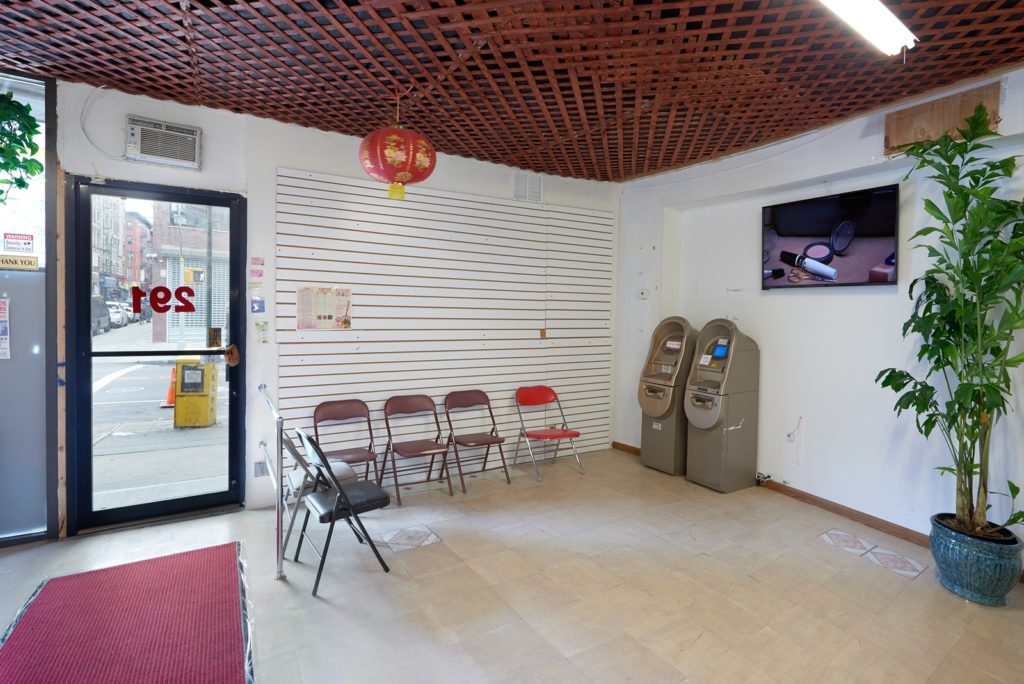Opinion
The Gray Market: Why Art Collecting Is Not Like an Oxycontin Addiction (and Other Insights)
This week, our columnist explores Beatrix Ruf's fall from grace, the Sacklers' OxyContin-based fortune, and Omer Fast in Chinatown.

This week, our columnist explores Beatrix Ruf's fall from grace, the Sacklers' OxyContin-based fortune, and Omer Fast in Chinatown.

Tim Schneider

Every Monday morning, artnet News brings you The Gray Market. The column decodes important stories from the previous week—and offers unparalleled insight into the inner workings of the art industry in the process.
This week, questioning alternative aspects of three art-industry scandals…
JUST SAY “NO”: On Monday, Christopher Glazek guided readers on an investigative deep dive into arguably the most private and prolific museum patrons in the US and the UK: the Sacklers. The family name currently graces courtyards, wings, and galleries at prestigious institutions that include the Met, the V&A, the Louvre, the Royal Academy, and the Smithsonian, among an almost comically long list of others.
But as Glazek’s story reveals in stomach-churning detail, the Sackler clan has been infinitely more interested in broadcasting its name than its history, and least of all the primary source of its billions. That source is OxyContin, the time-release prescription painkiller central to the American opioid epidemic, which a federal commission recently blamed for about 142 deaths per day, or “September 11th every three weeks.”
While Glazek spends the majority of the piece charting Oxy’s disinformation-fueled spread to epidemic proportions, his opening act lays bare some of the personal histories of the Sackler brothers: Arthur, Mortimer, and Raymond. And among them is Arthur’s rise and (relative) fall, allegedly through his obsessive collecting of art and antiquities. He writes…
As Arthur’s fortune grew, he turned his acquisitive instincts to the art market, quickly amassing the world’s largest private collection of ancient Chinese artifacts. According to a memoir by Marietta Lutze, his second wife…collecting soon became a mania that took over his life…Under an avalanche of ‘ritual bronzes and weapons, mirrors and ceramics, inscribed bones and archaic jades,’ their lives were ‘often in chaos.’ Lutze wrote: ‘Addiction is a curse, be it drugs, women, or collecting.’
Now, casting zealous art collectors as “addicts” is a trope that’s been floating around the industry like a dead raccoon in an untended backyard pool for as long as I can remember. Like Lutze, I’ve used it myself a few times. But I now think it’s as misleading as my other pet peeve in this realm: the fallacy that the art market is “completely unregulated.”
I’m not suggesting for a moment that collectors never overspend—even drastically sometimes. Nor am I suggesting that they never blow money on art that they should spend in other, vastly more beneficial ways—or even that they don’t hurt themselves or their loved ones to some degree as a result.
But here’s the thing: ART DOES NOT ACTUALLY WORK LIKE HARD DRUGS. The trigger, the stakes, and the dynamic involved in the former are all vastly different from the ones involved in the latter.
For example, no mogul is ever going to be found dead in an abandoned train car with frothy blood caked over his nostrils and a Basquiat canvas spiked into a bulging vein. One-time billionaires are not breaking into their relatives’ houses to steal TVs for cash to cop Richard Prince Nurses. Art-fair VIPs are not ass-smuggling small Giacometti sculptures across international borders to get better price-breaks on an acquisition they need to make every day to avoid torturous withdrawal symptoms or death.
Ironically, if collecting really COULD be addictive in the same ways as drugs, the art market might be slightly more stable than it is today. The opioid crisis became a crisis because opium/opioid addiction essentially pushes your standards down a flight of stairs as your resources dwindle. As Glazek points out, many well-off users of OxyContin eventually turn to heroin for a dirtier, cheaper fix, just as alcoholics who begin with Johnnie Walker Black can plummet to chugging straight mouthwash when there’s nothing else left.
But there is literally zero chance that, say, the billionaire collector Steven Cohen will ever be compelled—either chemically or economically—to start buying works by unheralded mid-career artists or freshly minted Yale MFA grads because he’s burnt through his acquisition fund on high-end work. For many, if not most, compulsive collectors, the high tends not to be the art.
Instead, as Lutze wrote of her ex-husband Arthur Sackler’s habit, collecting fuels a “driving necessity for prestige and recognition.” The social buzz, not the aesthetic value, is the addictive property. Which means that buying lower-tier (from a market perspective) work can’t scratch the itch for Collectors Only In Name (COINs)—and that the rest of us should stop the madness of comparing them and their more sophisticated counterparts to addicts once and for all. [Esquire]

Beatrix Ruf ©Robin de Puy
RUF TIMES: This past Tuesday, celebrated curator and power-broker Beatrix Ruf abruptly resigned her post as the director of the Stedelijk, shortly after Dutch newspaper NRC published multiple reports accusing her of indulging conflicts of interest around the art industry.
The allegations against Ruf include that she may have subordinated the museum’s interests (and budget) to collector Michael Borgmann, whose “gift” of 600 works and 10 long-term loans hinged in part on the museum’s decision to acquire seven works from his holdings at a drastically above-auction-market price of €1.5 million; that the €437,306 purported made by Ruf’s art-advisory firm was omitted from the Stedelijk’s 2015 annual report; and that her “active” role in Swiss publishing house Ringier was just as ghostly on the same document, even though it includes a field expressly intended to capture its director’s extracurricular proceeds.
Not surprisingly, the Stedelijk has PR-ready answers for most of the above. The museum said in a statement that all agreements regarding Borgmann’s collection “were thoroughly scrutinized at the time, and subsequently approved,” with the entire process carried out in accordance with “usual procedures with regard to transparency.”
Meanwhile, mention of Ruf’s involvement with Ringier in the museum’s report never materialized because of an “administrative error.” Whether or not the same clerical incompetence deserves blame for the omission of Ruf’s sizable advisory stack remains unclear.
Of course, the open question is whether these convenient explanations approach anything resembling the truth. Although I have no inside information, I’m skeptical.
The reality is that there are only three options for how this troika of gaffes could take place under the watchful eye of the Stedelijk’s Supervisory Board, which has a mission to monitor Ruf:
Explanation 1: It genuinely didn’t know about some of Ruf’s methods or moonlighting escapades
Explanation 2: It knew, but chose to lie about its level of knowledge until the press called Ruf to account.
Explanation 3: It chose to stay willfully ignorant of whatever Ruf might be doing in violation of the institution’s standards, likely because they felt she was doing a stellar job otherwise, and why ruin a good thing?
Here’s the problem: all three explanations make the board look really bad.
I don’t know what Ruf did or didn’t do. Nor am I trying to absolve her of responsibility in this high-level debacle. But I’m equally unsure that we should leave the search for real answers to the “external, independent governance expert” hired by the Stedelijk’s Supervisory Board in the aftermath of this scandal to investigate—you guessed it—the Stedelijk’s Supervisory Board.
As its public answers to date suggest, the institution’s monitoring body has every incentive to try to pirouette around its fair share of scrutiny for Ruf’s departure. Here’s hoping journalists at NRC and elsewhere now turn the spotlight on the board as intensely as they’ve turned it on Ruf herself. [artnet News]

Installation view, “Omer Fast: August,” James Cohan, New York. Photo by Phoebe d’Heurle
FAST MONEY: Finally this week, Omer Fast became the latest contemporary artist to jam a stick into the hornets’ nest of cultural scandal in 2017, with the consequences still very much to-be-determined.
The source of the trouble is the environmental installation that Fast created in James Cohan’s Chinatown space as the setting for the two video works comprising the core of “August,” his current exhibition there. In the words of Holland Cotter, the surrounding gallery now poses as “a funky Chinatown shop or bus-company waiting room with metal chairs, broken A.T.M.s and a shabby facade.” Cotter frames the problem as being that Fast—Israeli-born and now Berlin-based—renders his “‘waiting room’ not as a replication of any real Chinatown but as the kind of fantasy version of immigrant neighborhoods evoked to justify ‘slum clearance.'”
The show opened on September 16, but the stink seems to have taken nearly a month to build to a point where many of us in the art media caught wind. On October 2, the Chinatown Art Brigade posted an open letter to Cohan blasting Fast’s installation for promoting racist stereotypes about Chinese immigrants. Protesters descended on the space last Sunday with picket signs, chants, and posters to plaster onto the building’s exterior. Fast and Cohan released statements in response this past week (both of which currently live on Cohan’s website), and the verbiage in those statements provoked a second wave of public vitriol from activists, critics, and other observers.
Rather than provide further commentary on the slow-motion ethical face-plant taking place here, though, I want to focus on how this scandal may or may not affect Cohan’s business going forward. Unlike this year’s other widely covered controversies over cultural appropriation by artists, this one is unfolding in the gallery sector, not the museum sector. And as unhappy as it’s likely to make many people, this means that, from an economic perspective, negative public opinion should affect James Cohan much less than a major institution.
Anyone concerned can find out which donors helped fund an ethically dubious museum show or which museums accepted cash from ethically dubious sources. All of that information is publicly available, and its revelation can trigger significant, tangible consequences for the parties involved—a fact we just saw again recently when the Guggenheim pulled three scandalous artworks from its show “Art and China After 1989: Theater of the World.”
But as with most other private art deals, it approaches the impossible for aggrieved people to ever know who (if anyone) ends up acquiring the two video works being offered in Fast’s show. (The same is true for whatever other works may be available in Cohan’s private back rooms, too.) In this sector of the industry, potential collectors are shrouded in a cloak of invisibility—and thus, invincibility to scandal.
In short, even if every resident of New York were to explode a full adult diaper on Cohan’s façade in protest, then clean-up costs aside, the backlash would be financially irrelevant to Fast’s show—at least, as long as Cohan was able to find a handful of collectors willing to buy the pieces that seem to have caused no adverse reaction whatsoever.
Of course, that isn’t to say that neither Cohan nor Fast will be acne-scarred by this scandal over the long term in more subtle ways. (To paraphrase media critic Jay Rosen of PressThink, anyone who believes there’s no such thing as bad publicity has probably never been on the receiving end of bad publicity.) Nor am I suggesting that the protesters’ views are wrong, or that their efforts are meaningless in more important dimensions than dollars and cents.
I am, however, suggesting that even a public insurrection over cultural insensitivity is unlikely to have much of an effect on the private art market—and that this is worth keeping mind when considering how viral protests will (or won’t) influence art production in the years ahead. [ The New York Times ]
That’s all for this edition. Til next time, remember: In every scandal, there’s usually more to criticize than just the main event.